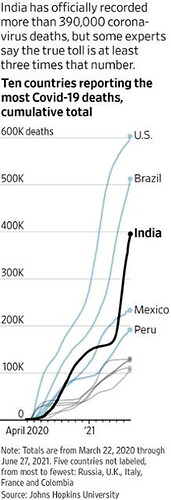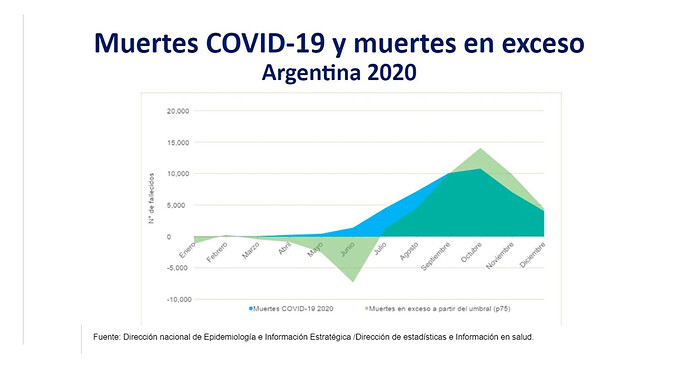I know they’re going to do exactly zero about this. They’re not interested in respectability
They don’t care because they did it on purpose. The author didn’t misinterpret the graph. They misrepresented it.
Yup. It was clickbait.
I subscribed to the NYT for a while, but I’ve dropped it.
I used to buy the NYT every Tuesday, for the Science Times feature. I also used to subscribe to Scientific American.
Anyway, that was a long time ago.
You don’t think your admonishment of them is going to influence their reporting & data viz going forward?
You must think the Pulitzer has more cachet than “Mortality with Meep.”
PS. “NYC Angry Mom”'s whole thread is worth a perusal.
Yes, I saw. It’s lovely when the same sorts of people give prizes to themselves.
That’s generally how it works w/ any group that gives out prizes. Oh well.
I thought the Economist did a great job conveying info on COVID in a meaningful way. I definitely went to them before the NYT.
Okay, I combined some of the mortality stuff into one post
If you’re a member of SIR, you can sign up for the Life/Health roundtable for this Thursday, June 24, 1-2pm ET
https://www.sirnet.org//SIR/Events/Webinars/Webinar-Registration.aspx?EventKey=CICALL5
Some portion of the meeting will be me talking about non-COVID excess mortality
Excerpt:
COVID-19 Had a Devastating Impact on Medicare Beneficiaries
in Nursing Homes During 2020Key takeaways
• two in five Medicare beneficiaries in nursing homes were diagnosed with either Covid-19 or likely Covid-19 in 2020
• Almost 1,000 more beneficiaries died per day in April 2020 than in April 2019.
• Overall mortality in nursing homes increased to 22% in 2020 from 17% in 2019.
• About half of Black, Hispanic, and Asian beneficiaries in nursing homes had were likely had Covid-19, and 41% of White beneficiaries did.
• Understanding the pandemic’s effects on nursing home residents is necessary if tragedies like this were to be averted.
I’m not sure where to put this as it’s related to both mortality and vaccines, but this seems at least sufficiently appropriate:
snips from the article with bold for emphasis
Nearly all COVID-19 deaths in the U.S. now are in people who weren’t vaccinated, a staggering demonstration of how effective the shots have been and an indication that deaths per day — now down to under 300 — could be practically zero if everyone eligible got the vaccine.
An Associated Press analysis of available government data from May shows that “breakthrough” infections in fully vaccinated people accounted for fewer than 1,200 of more than 853,000 COVID-19 hospitalizations. That’s about 0.1%.
And only about 150 of the more than 18,000 COVID-19 deaths in May were in fully vaccinated people. That translates to about 0.8%, or five deaths per day on average.
…
The preventable deaths will continue, experts predict, with unvaccinated pockets of the nation experiencing outbreaks in the fall and winter.
I would hope most COVID deaths were among unvaccinated people at this point.
They have been the entire time.
Studies with obvious results, COVID edition?
Though then I see this in an article today, emphasis mine:
Of Utahns who have been fully vaccinated, 1,331 have gotten sick 14 days or more after being fully vaccinated, and three have died. Over 130 have been hospitalized.
Your quote does not include the stats for the unvaccinated. So, what conclusion should I, a reasonable person, make?
Also, “3” is a small number. I hope we can agree on that.
Here is a source similar to whatever you were reading:
A paragraph similar to yours, but emphasis mine:
The state reports 1,331 breakthrough cases, 131 hospitalizations and three deaths since the start of the vaccination process in December. That breaks down to about 102 new cases per 100,000 people vaccinated or about 0.1% of Utahns who are fully vaccinated.
Then, further down:
On June 1, the seven-day case rate for vaccinated Utahns was 8.2 per 100,000, while the case rate for unvaccinated Utahns was 64.1 per 100,000.
Further down:
Another dataset shows the number of daily cases broken down between vaccinated and unvaccinated Utahns. So on June 1, unvaccinated Utahns accounted for 90% of new cases.
But as the total number of new Utah cases has slowly risen over the past few weeks, so have cases involving vaccinated and unvaccinated Utahns. The breakthrough cases just aren’t rising as sharply as unvaccinated cases.
Your emphasis is too scant.
Oh wow. Utah still has pretty high infection rates. Er, and its total rate is 9.7 and rising. 
looking at 91-divoc:
CA is at 2.3 (seven day average rate/100K) and stable
NM is 4.5 and stable
CO is 6.9 and dropping
VT is below 1 and dropping. Of course, VT does lead the nation in vaccinations.
Is there a source for:
- Unvaccinated infection rates by state, and
- Vaccinated infection rates by state?
Wondering if these two are somewhat similar across states, yet the percentage of vaccinated is the major (only) difference in overall averages.
They’ve been different throughout the pandemic, so I would guess they are different now. Weather and luck are both factors, I think, as well as vaccination, population density, and how much people are interacting with each other.
Also, vaccines aren’t perfect. Vaccinated people who live in places with tons of infected unvaccinated people are more likely to get infected than vaccinated people who live in places with a lower background rate. (Same for unvaccinated, of course. But that will affect even the vaccinated.)
Excerpt:
India has officially recorded more than 390,000 coronavirus deaths, but families who have lost loved ones, health experts and statisticians say that vastly undercounts the true toll. Families like Mrs. Singh’s have been left struggling to get compensation that some states have set up for Covid-19 victims.
India’s undercount has also left a huge gap in the world’s understanding of the impact of the Delta variant, which health experts believe helped drive one of the world’s worst Covid-19 surges in April and May. India was the first to detect the highly infectious variant, which has hopscotched around the world. It is fueling a surge in the U.K., and is expected to become the dominant variant in the U.S.
The undercounting of infections and deaths is a problem world-wide, even in countries with widespread testing. The World Health Organization said last month that the global Covid-19 death toll could be two or three times the official number. The problem, however, is particularly acute in the developing world, where access to healthcare and coronavirus testing is often more limited.
…
To qualify for its Covid-19 compensation payment of 400,000 rupees, equivalent to about $5,400, the state requires a report from a certified lab, which at the time were taking days to process.The family got a test strip from the lab indicating that Mrs. Singh was positive and rushed to a doctor.
…
Health experts say many Covid-19 deaths have gone uncounted among India’s vast population of rural poor, who have little access to healthcare or Covid-19 testing.Mr. Banaji, the mathematician, says the central government has tended to praise states with low death counts and castigate those with higher counts as incompetent. “This narrative of success and failure centered on fatality numbers is very dangerous,” he said.
Sounds like a lot of bad incentives all around.
Argentina
auto-translated:
Due to the coronavirus, Argentina registered 36,306 more deaths in 2020 than the average of the last five years
It is 10.6% more than expected, compared to the deaths that occurred between 2015 and 2019. The peak of deaths occurred in October, according to the presentation of a mortality report made today by the Ministry of Health and the one that participated Infobae

